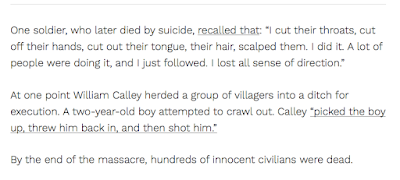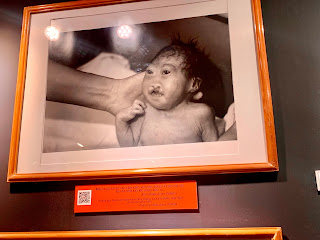29th Dec 2022 - 4th Jan 2023
I paid a return visit to the 'War Remnants Museum' north of the centre (left). This is now a modern hi-tech museum covering both the French and American conflicts. As you can imagine the displays are somewhat biased in favour of the gallant and patriotic Vietnamese.
It has been much revamped since my last visit several years ago and there were many tourist visitors.
Right: There is a large display of aircraft, armoured vehicles and weaponry involved in the conflicts placed around the outside. The displays inside are on three floors.
In fact, it was from inside here that I got most of the photos (of photos) shown in a previous blog.
Left: On the way up I passed the front gates of the Independence (or Reunification) Palace. It was formerly the Presidential Palace and where the famous 'iconic' photo was taken of an NVA tank smashing through the gates in 1975.
Right: I also passed the 'Palais de Justice' which I show as another example of rather splendid French architecture; rather spoilt by the large tent at the front.
Left: Also, on the way back, in front of the Independence Palace, was a stage where they were rehearsing an act for New Year's Eve. It featured the 'famous' Vietnamese pop star Dam Vinh Hung. No doubt you know of him? He is the one in the white T-shirt (you can just make him out if you look carefully). I'm afraid I didn't see the performance on NYE. Other things to do.
During the course of these few days I paid a social visit to a restaurant called 'Les Trois Gourmands'. It is in the Thao Dien district (District 2) which is just south of the Saigon River. This is owned and run by a formidable and charming lady, Mme Phuong, who previously, with her now sadly deceased French husband Giles (a sommelier), ran another great place, a restaurant and guest house, called Le Toit Gourmand in the northern Tan Binh district and where I resided very happliy (15 years ago!) for a couple of years. Les Trois Gourmands is one of, if not the, premier 'gourmet' restaurants in the city (with prices to match!). Well worth a visit for a special occasion. Above: Mme Phuong (right) with another lady, Chieu, who also worked at the previous Toit Gourmand. They seemed glad to see me and I was given a rather good glass of wine. Santé! Hẹn gặp lại !
While on the subject of excellent places to go to eat and drink when in this city, another worthy of praise and recommendation is 'The Refinery', a cosy brasserie in a secluded courtyard at 74 Hai Ba Trung Street, near the central Lam Son Square. It is owned and run by a French lady called Noëlle Carr-Ellison and has always attracted lots of 'ex-pats' (and tourists and locals) over the years. The Refinery is called thus because it is on the site of an old opium refinery when those things were in fashion. I visited this time (actually more then once) when there was a typical tropical downpour. When it rains here it doesn't just pour down, it is a veritable biblical deluge and normally lasts for about 10 minutes. It is quite alarming and noisy, but the bucketing water is at least warm. Photo above is of the downpour from the inside comfort. I could hardly hear myself eat and drink.
Left: The Amman emporium at the southern end of Hai Ba Trung Street, City centre. This is Saigon's equivalent of London's Fortnum and Mason. On two floors it sells all the upmarket goods you can expect from any of the Western, and worldwide, premium food and drink outlets (at a price!). If you want such things as Patum Pepperium Gentleman's Relish, caviar or any top-of-the-range drinks, as well as Tetley tea bags, they will have them. There is also a smart café/bar on the 2nd floor which does impeccable tea, scones and sandwiches.....as well as, to cater for the likes of me; wine and peanuts.
For some reason many people, especially tourists, were wearing these luminous ears on their heads (right). Or are they horns? Talking of tourists, why is it nowadays that 98% of all male (maybe also some female as apparently we can call ourselves whatever gender we like nowadays) Westerners between the ages of 18 to 40 sport scruffy unshaven facial stubble? The English cricket team and Andy Murray (tennis player) are prime examples. Is this fashion or simply laziness? Whichever, I think it looks most unattractive.
Below: A tuneful Vietnamese lady singing an appropriate song in the ground floor bar of the Caravelle Hotel.
I show some buildings and structures around town.
Down by the river is this statue of Tran Hung Dao (right), an iconic warrior from the 13th century.
Left: ....and behind him, the Vietcombank Tower, a mere 36 storeys and 676ft high.
Right: The Bitexco Tower, with helipad and viewing platform at the top, with a rather expensive bar and restaurant. I have visited this up top previously and photos in a blog somewhere. It has 68 floors and 861ft high.

Right: A pretty girl. There are so many around this part of the world; always well turned out, slim and with nice hair, and smiling and happy. Somewhat dissimilar to most in my home town.
Left: This chap was selling sunglasses, as were many others on the beach at Nha Trang, for example. I never saw him, or them, sell one. There was another lady selling backscratchers in similar fashion. Very useful I'm sure and I hope she did better business.
Below: Back at the rooftop-bar of the Caravelle Hotel. The jolly Cuban girls and band were at it again. They manage to get people up to to dance. Apart from me, that is.
 On NYE the streets were thronged with people and 'motos'. They were making the most of New Year's Eve. Right: 'If pigs could fly'! Outside the Opera House.
On NYE the streets were thronged with people and 'motos'. They were making the most of New Year's Eve. Right: 'If pigs could fly'! Outside the Opera House.Left: A chap performing a spectacular 'flame-blowing' act. I expect he probably singed his eyebrows, as well as those too close-by.
Right: A popular entertainment, mainly with children being instructed to ride these gyroscopically stabilised mobilty things, whatever they are called. I had a go and it was quite fun and easy to get the hang of it. I expect they would be banned in UK for not complying with any legally enforceable means of transport.
I managed to 'scam' my way into the (guests only) rooftop bar at the Rex Hotel, overlooking Nguyen Hue boulevard, which runs down to the Saigon River from where the fireworks were due to be launched. I was even given a complimentary glass of wine. Left: The crowds had gathered below in expectation.
Right: There was a band and singers up there to entertain us prior to the fireworks.
Right: Just prior to midnight, a group armed with champagne bottles assembled on the stage ready to pop corks to welcome in 2023. (7 hours ahead of UK).
The fireworks! A spectacular display which went on for 20 minutes. They even managed to control the lights on the tall building to read, roughly, 'Happy New Year'. Very clever.
So that was New Year's Eve, and a very jolly occasion it was. After most of the guests at the Rex had eventually thinned out they had left behind a large quantity of unfinished drinks in half full bottles. Guess who helped himself!
Right: Another pretty girl. I can't help myself! They were always very happy to have their photos taken. Chúc mừng năm mới ! to you all.
So, back to Blighty. A decent, if unremarkable, 14 hour+ trip on Bamboo Airlines again. I arrived at London Gatwick airport (Gatport Airwick) at 8.30am on the 4th Jan to be greeted by cold and miserable fog and drizzle in true British tradition, together with various organisations going on strike, "We want more Pie", a concept totally alien in Vietnam. Actually, after landing at Gatwick it took over 20 minutes to taxi from the runway to the terminal. I think, with visibility down to about 50yds, the pilot must have got lost in the fog! Fortunately the trains from Gatwick via London Underground to Paddington and then on to Reading station were operating normally. From then on nothing. They were on strike! I made it home with help from a friend.
Do you wonder why I do a 'Chrexit'?















































